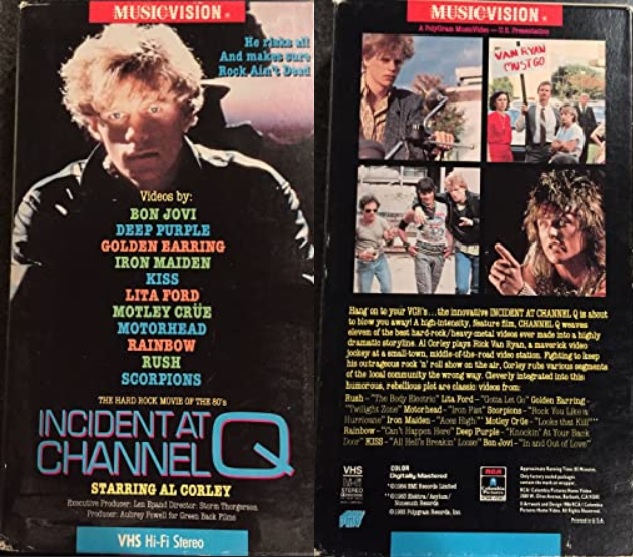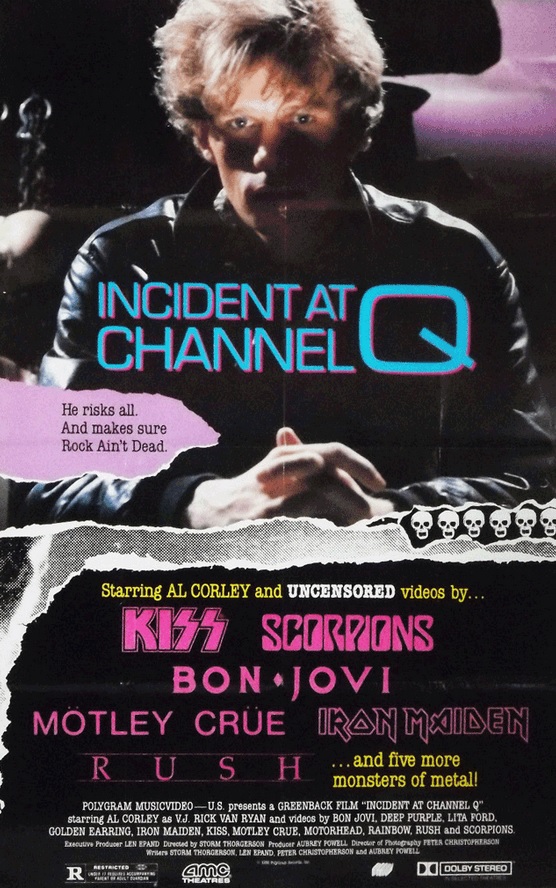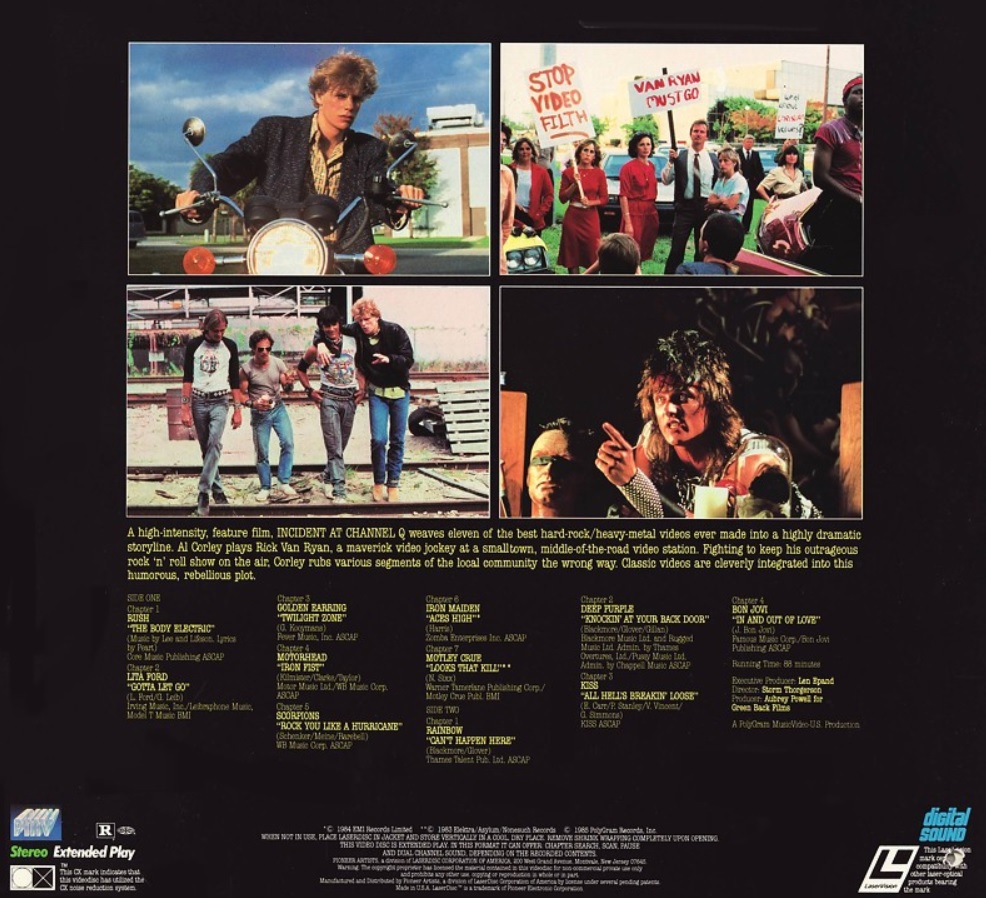After posting our review of Charles Band’s Bad Channels for our “Radio Week” of reviews regarding films set inside radio stations (March 15 to 21), this Al Corley-starring and Storm Thorgerson-directed movie (well, long-form Escher’s “Magic Mirror” video that features videos within the video) popped into my head. Yeah, it takes place inside an UHF-TV station and not a radio station; it features a VJ and not a DJ. But my memories of Incident at Channel Q “peanut butter into my chocolate,” if you will, with Bad Channels courtesy of an old Books-A-Million location (or was it a Waldenbooks?) that carried used copies of VHS tapes in their cut-out bins.

If you were a metal head in the early ‘80s, this movie holds fond memories for you. If you’re a younger lad and a new inductee to the world of ‘80s metal, courtesy of the hosts of SirusXM Satellite Radio’s Hair Nation, who’ve mentioned this slice of metal nostalgia on several occasions, you’re clamoring for a copy.
And I am clamoring for one ever since my copy became infected by the blue screen of death alongside my copy of The Dark Backward. Frack you, Starbuck.
If there’s ever an old VHS that needs an official DVD/streaming reissue, Incident at Channel Q is the movie. (Shameless plug: read our “10 Movies That Were Never Released to DVD” featurette.) Hell, we’d even settle for a forbidden world grey market impress at this point. The VHS and even rarer Laser Disc pop up on seller sites from time to time—if you want to donate a kidney for it. And how is it the IMDb page for Incident at Channel Q is a barren wasteland? There’s no photo stills? Not even an image of the VHS? It’s not even rated at Rotten Tomatoes? Not even a Discogs page for its soundtrack?
Yeah. You’re damn right it’s time to show this VHS gem the love. Load the tape. Let’s rock.

As you look at the theatrical one-sheet, you notice the logo for AMC Theatres: the theatre chained backed the production and distributed it as an exclusive midnight movie—which was my first exposure to it. Later, I rented the RCA/Columbia Home Video copy from my corner video store. And I begged the horseshoe-haired, garlic-pepperoni halitosis guy running the joint to please sell me the one-sheet hanging in the store. Of course, he did not. (Insert “word” for lower abdominal appendage. Frack you, film nerd.)
The Midnight Movie
Prior to the advent of video stores and cable television in the ‘80s, the midnight movie was a ‘70s marketing gimmick for non-commercial films, mainly exploitation films and just about everything that made the dreaded “video nasties” list. (Shameless plug #2: check out our three part “Exploring: Video Nasties” featurette.)
Sam Raimi’s The Evil Dead, the animated rock flick Heavy Metal, and Pink Floyd: The Wall broke as midnight movies.
For those of us too young to go to concerts: We got to see Led Zeppelin for the first time in The Song Remains the Same (1976). We became “Dead Heads” courtesy of The Grateful Dead Movie (1977). We got a double dose of Black Sabbath and Blue Oyster Cult with Black and Blue (1981). Our first AC/DC concert (distributed by Fred and Beverly Sebastian of Rocktober Blood fame; also a midnight movie, natch) was AC/DC: Let There Be Rock (1980). And how can we forget The Rocky Horror Picture Show. (Shameless plug #3: read about Kim Milford, the original Rocky, and his rock flick Song of the Succubus.)
And since the nascent MTV video network wasn’t cleared for broadcast in all markets and all cable systems, the only way you could see rock videos—besides an errant, overnight video program on some low-wattage UHF-TV station—was in a movie theatre—some of which would run videos before their midnight movie features; in-between if it was a double feature.
Incident at Channel Q: Behind the Q
It’s the brainchild of the British graphic design company Hipgnosis founded by Storm Thorgerson and Aubrey Powell. Do we really have to rattle off all of the top-selling album covers they’ve designed? Name a classic rock artist from the ‘60s to the ‘80s and, odds are, Hipgnosis designed the cover. (Def Leppard’s High ‘n Dry, with the image of a man diving into a swimming pool? That’s a rejected Pink Floyd Hipgnosis cover, for example.) When music videos became de rigueur, Hipgnosis incorporated Green Back Films—and the hits continued with Robert Plant’s “Big Log” and “Owner of Lonely Heart” for Yes, just to name a few. Hipgnosis formed Green Back in a partnership with Pink Floyd associate and noted documentarian Nigel Lesmoir-Gordon. One of Lesmoir’s films was the “ancient future” classic, The Colors of Infinity, starring science-fiction writer Arthur C. Clarke.
If you’ve familiar with Christian Slater’s “Hard Harry” from the Pump Up the Volume (1990), then you’re up to speed on the antics of VJ Rick Van Ryan (Al Corley), a sarcastic agent provocateur at a struggling South Florida UHF-TV station, Q 23 (actually Fort Lauderdale’s WKID-51 doubling for the small-town of “Springfield”), which flipped to an all-rock video format. As with Karlan Pickett being hired over at KRZY “Power 98” in the frames of Power 98: the management hates the jock, but they “love the numbers,” so the Devil’s radio, uh, TV station, it is.
Of course those teenaged metal-scamps love Rick! But, uh-oh, the Christian conservatives lit the torches and sharpened the pitchforks demanding that “satanic program,” Heavy Metal Heaven, be taken off the air because, well, you know, there are souls to be saved. And like any Nancy Pelosi-fearing Christian who doesn’t “hate people,” but “prays for them,” the station’s God-fearing hosts and sponsors want Rick off the air. And to that end: a couple of right-wing bullies are hired to “wise up Rick” with a good ‘ol fashioned, Christian beat down, you know, for God and country. To hell with the Devil: even if it means grievous bodily harm, for the bible told them so.
That’s it, Rick’s had enough. So taking a cue from the staff of the “other station” with a Q—Los Angeles’ QKSY-FM 7-11 (FM), he barricades himself inside the TV station and rallies the metal head masses (well, okay, 12 people) in an Airheads-style revolt.
The Rock Video Rundown
Incident at Channel Q is pure homage (most critics miss that point) to those old Alan Freed DJ-starring films from the ‘50s—Rock Around the Clock, Rock, Rock, Rock, Mister Rock and Roll, Don’t Knock the Rock, and Go, Johnny, Go!—and to that end: it’s all about musical numbers and not the story. Sometimes, with those old rock flicks, the bands didn’t even appear “live” in the film as “actors”; the film would “cut away” to a TV performance (of an old band clip, natch) that the kids were watching. So Rick Van Ryan loading up videos is the equivalent of that narrative approach. Thus, while it would have been awesome to have had Iron Maiden showing up for a live parking lot concert to support Rick’s quest, we get video clips inserted into the action from:
Rush – “The Body Electric”
Lita Ford – “Gotta Let Go”
Golden Earring – “Twilight Zone”
Motorhead – “Iron Fist”
Scorpions – “Rock You Like a Hurricane”
Iron Maiden – “Aces High”
Motley Crue – “Looks that Kill”
Rainbow – “Can’t Happen Here”
Deep Purple – “Knockin’ at Your Back Door”
Kiss – “All Hell’s Breaking Loose”
Bon Jovi – “In and Out of Love”

Hell, yeah! Incident at Channel Q is an ‘80s rock fan’s dream, with some of the greatest metal videos of all time featuring more than enough poofy hair, tight pants and studded leather, debauchery, depravity and post-apocalyptic imagery (shamless plug #4: check out our month-long homage to apoc films with our two-part Atomic Dustbin round up) to satiate our devil-influenced, MTV nostalgia.
The Cast
None of the South Florida community actors cast in the film starred in anything else after making their feature film debuts on Incident at Channel Q. But proving everyone has to start somewhere:
Camera and Lighting Department gaffer Greg Patterson embarked on a successful career in his field, working on Stallone’s The Specialist, The Dark Knight Rises (2012) and Harrison Ford’s most recent film, The Call of the Wild (2020).
Barry J. Anderson was another of the South Florida acting hopefuls who auditioned for one of the metal scamps, but earned a part as one of the background acting, protesting metal hoards (so jealous, I’d love to have been one of them, but I wasn’t acting at the time). In addition to working as a recurring background actor on Miami Vice in the series’ squad room, Anderson became a special effects engineer and make-up artist on several Florida-produced “video nasties,” such as Ted V. Mikels’s Astro Zombies: M4 (2012), then worked his way up to more prestigious horror films, such as George Romeo’s Day of the Dead (1985), Scared Stiff (1987), The Unholy (1988), the remake of Hairspray (2007), as well as the Jeepers Creepers and The Butterfly Effect franchises.
Actor Charles Knight, who played the character Horowitz, the station’s engineer with hopes of becoming a metal host at Channel Q (he appears on the bottom right corner on the rear of the VHS and Laser Disc artwork), came by his role, accidentally, by way of his ex-girlfriend actress. His actress ex was auditioning for a principal role in Miami Beach as he waited in his car outside. A “British dude” leaned in and asked Knight if he was there to audition. Knight explained why he was there. The British dude said that Knight “had the look that they wanted” and invited him in for a cold reading. He read for the part of Vinnie, but the role had already been promised, so he was cast-on-the-spot as Horowitz. Charles Knight still resides in Florida and has acted in a couple indie films.
The Al Corley Lowdown
The Wichita, Kansas-born Al Corley got his start as a doorman at New York’s famed Studio 54 in the late ‘70s and appeared in a VH 1 Behind the Music special to recount his experiences. The contacts Corley made at the club transitioned him into an acting career; he was soon cast as the first Steven Carrington for 37 episodes during the 1981 to 1982 season of the popular ABC-TV prime time soap opera Dynasty. (And, in prime soap opera fashion: Corley was recast with a “new” actor via “plastic surgery after an oil rig explosion.” No, really.)
During those years, Corley was in a relationship with Carly Simon. So deep was the love that he appears on one of her album covers; that’s his back to the camera on the album artwork for 1981’s Torch (this Carly Simon blog regarding her album covers chronicles Corley’s involvement). You know Carly from the ‘70s song “Anticipation” and her James Bond theme song “The Spy Who Loved Me.” (Shamlesss plug #5: April is “James Bond Month” at B&S About Movies.)
But Corley was always a musician first and foremost (his Discogs page) and he, like American TV actors David Soul, Rick Springfield, Don Johnson, and David Hasselhoff before him, embarked on a successful European singing career across three albums: Square Rooms (1984), Riot of Color (1986) and Big Picture (1988). His debut album produced two European Top 20 singles/videos: “Square Rooms” and “Cold Dresses,” with the title cut single reaching number one in France. His other Top 100 Euro-hits were “After the Fall” from Riot of Color and “Land of the Giants” from Big Picture.
Those hits, in turn, netted Corley the lead in the 1989 West Germany-produced feature film Hard Days, Hard Nights (aka Beat Boys), a very loose, pseudo-Beatles bioflick about a Liverpudlian rock band’s quest for stardom in Hamburg. And rock on this: Corley’s co-star, in his acting debut, was Nick Moran: you know, Scabior from the Harry Potter franchise. Moving into directing, Corley fronted the MGM rom-com Bigger Than the Sky (2005; you can watch it for free on Vudu).
This Is The End, My Friend
And that, my wee rockers, is the story behind Incident at Channel Q . . . and you can rock with this full video-soundtrack recreation I cooked up on You Tube.
What’s that? You need more punks and metal heads on film? Ack! Not more shameless plugs! Then check out our explorations “No False Metal Movies” and “Ten Bands Made Up For Movies.” And these excellent Letterboxd lists (see, we plug others) for Heavy Metal Movies and Punks on Film will also help you on your quest for ye metal.
Keep the horns high! That’s it for “Radio Week” kids. We’ll have an “Exploring: Radio Stations on Film” round up with links to all of this week’s films this evening at 6 PM.
About the Author: You can read the music and film reviews of R.D Francis, as well as short stories based on his screenplays, on Medium. You can learn more about his work on Facebook. He also writes for B&S About Movies.
Hello and thank you for this informative and thoughtful look into the film. My name is Charles Knight and I played the character Horowitz who was the station engineer with hope of becoming a metal host at Q. My ex was auditioning for a principal role in Miami Beach while I was waiting in my car outside and a British dude leans in and asked if I was there to audition. I told him why I was there and he said that I had the look that they wanted and invited me in for a cold reading. I read for the part of Vinnie but the role had already been promised so I was immediately cast as Horowitz. I still reside in Florida and have acted in a couple indie films. On the back cover of Incident I’m the bottom right photo.
LikeLiked by 1 person
Charles, if you come back and see this: The wild thing is, for as many times as I’ve watched this, I do remember “Horowitz” in the film and your scene captured on the cover. So glad you discovered the review and thanks for adding to the tale of the Q with your backstory on the film.
LikeLike